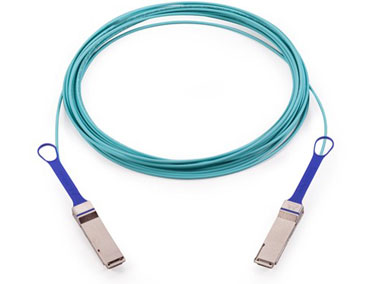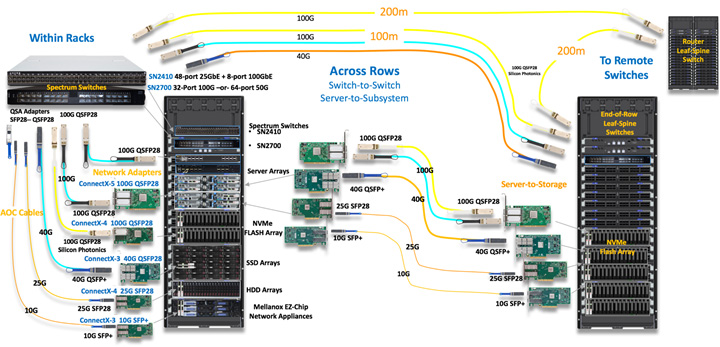By Majeed Ahmad, contributing editor
Active optical cable (AOC) technology is quickly emerging as a replacement to direct attach copper (DAC) cables in data center environments. Moreover, while moving beyond high-performance computing (HPC) clusters and Ethernet applications, AOCs are now eyeing opportunities in the digital signage and personal computing segments.
According to Communications Industry Researchers (CIR), the revenue from AOCs will climb from $1.1 billion in 2017 to $8.9 billion by 2022.

Image: Mellanox.
First and foremost, as server connections shift from 10-Gbps to 25- and 50-Gbps speeds, AOCs become an attractive alternative to DAC cables in large data center installations. The hyper-scale data centers are scrambling to install 100-Gbps links due to an exponential rise in server interface transmission rates. And AOCs offer a smoother path to 100-Gbit Ethernet (GbE) environments.
Next, as digital signage applications adopt ultra-high-definition video and start making use of data mining and big data technologies, they inevitably need more bandwidth. Therefore, AOCs are being employed to connect signage to content sources and control centers.
Even the consumer space is eying AOCs for high-speed serial bus (HSSB) technologies such as Thunderbolt 3. As USB Type-C and Thunderbolt 3 interface technologies break the speed barriers, personal computers enabled with these serial buses could use the plug-and-play AOCs for display extenders, personal video editing, gaming consoles, etc.
What’s different about AOC
While optical connectors disconnect the fiber from the transceiver, what AOCs do is bond the fiber connection inside the transceiver end, thus creating a complete cable assembly much like a DAC cable. However, AOCs boast 3-m to 200-m reach as compared to DAC’s 3- to 7-m transmission range.
Apart from transmission distance, other benefits over DACs include lower weight and tighter bend radius, which leads to simpler cable management. Next, AOCs offer lower costs and have no cleanliness issues that haunt optical connectors.
The AOC interconnect technology also boasts lower insertion and return loss. Furthermore, AOCs are easier to manage because they eliminate the need for elaborate and expensive optical test equipment. All the AOC testing can be conducted in the electrical domain.

Image: Mellanox.
So what’s next for the AOCs? The demand for 40 GbE is peaking, and as mentioned above, the 100-GbE versions of AOC have arrived to keep the mega data centers going. The year 2017 could well be the year of AOC technology.
Advertisement
Learn more about Electronic Products Magazine





